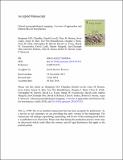Files in this item
Glacial geomorphological mapping : a review of approaches and frameworks for best practice
Item metadata
| dc.contributor.author | Chandler, Benjamin M.P. | |
| dc.contributor.author | Lovell, Harold | |
| dc.contributor.author | Boston, Clare M. | |
| dc.contributor.author | Lukas, Sven | |
| dc.contributor.author | Barr, Iestyn D. | |
| dc.contributor.author | Benediktsson, Ívar Örn | |
| dc.contributor.author | Benn, Douglas I. | |
| dc.contributor.author | Clark, Chris D. | |
| dc.contributor.author | Darvill, Christopher M. | |
| dc.contributor.author | Evans, David J.A. | |
| dc.contributor.author | Ewertowski, Marek W. | |
| dc.contributor.author | Loibl, David | |
| dc.contributor.author | Margold, Martin | |
| dc.contributor.author | Otto, Jan-Christoph | |
| dc.contributor.author | Roberts, David H. | |
| dc.contributor.author | Stokes, Chris R. | |
| dc.contributor.author | Storrar, Robert D. | |
| dc.contributor.author | Stroeven, Arjen P. | |
| dc.date.accessioned | 2019-07-31T23:41:34Z | |
| dc.date.available | 2019-07-31T23:41:34Z | |
| dc.date.issued | 2018-10 | |
| dc.identifier | 255192642 | |
| dc.identifier | 82548d45-dd49-4e40-b030-2ae87349aff7 | |
| dc.identifier | 85051365154 | |
| dc.identifier | 000448493500037 | |
| dc.identifier.citation | Chandler , B M P , Lovell , H , Boston , C M , Lukas , S , Barr , I D , Benediktsson , Í Ö , Benn , D I , Clark , C D , Darvill , C M , Evans , D J A , Ewertowski , M W , Loibl , D , Margold , M , Otto , J-C , Roberts , D H , Stokes , C R , Storrar , R D & Stroeven , A P 2018 , ' Glacial geomorphological mapping : a review of approaches and frameworks for best practice ' , Earth Science Reviews , vol. 185 , pp. 806-846 . https://doi.org/10.1016/j.earscirev.2018.07.015 | en |
| dc.identifier.issn | 0012-8252 | |
| dc.identifier.other | RIS: urn:7627AC059224B6B5B4F86E902D6FEB7B | |
| dc.identifier.uri | https://hdl.handle.net/10023/18224 | |
| dc.description.abstract | Geomorphological mapping is a well-established method for examining earth surface processes and landscape evolution in a range of environmental contexts. In glacial research, it provides crucial data for a wide range of process-oriented studies and palaeoglaciological reconstructions; in the latter case providing an essential geomorphological framework for establishing glacial chronologies. In recent decades, there have been significant developments in remote sensing and Geographical Information Systems (GIS), with a plethora of high-quality remotely-sensed datasets now (often freely) available. Most recently, the emergence of unmanned aerial vehicle (UAV) technology has allowed sub-decimetre scale aerial images and Digital Elevation Models (DEMs) to be obtained. Traditional field mapping methods still have an important role in glacial geomorphology, particularly in cirque glacier, valley glacier and icefield/ice-cap outlet settings. Field mapping is also used in ice sheet settings, but often takes the form of necessarily highly-selective ground-truthing of remote mapping. Given the increasing abundance of datasets and methods available for mapping, effective approaches are necessary to enable assimilation of data and ensure robustness. This paper provides a review and assessment of the various glacial geomorphological methods and datasets currently available, with a focus on their applicability in particular glacial settings. We distinguish two overarching ‘work streams’ that recognise the different approaches typically used in mapping landforms produced by ice masses of different sizes: (i) mapping of ice sheet geomorphological imprints using a combined remote sensing approach, with some field checking (where feasible); and (ii) mapping of alpine and plateau-style ice mass (cirque glacier, valley glacier, icefield and ice-cap) geomorphological imprints using remote sensing and considerable field mapping. Key challenges to accurate and robust geomorphological mapping are highlighted, often necessitating compromises and pragmatic solutions. The importance of combining multiple datasets and/or mapping approaches is emphasised, akin to multi-proxy approaches used in many Earth Science disciplines. Based on our review, we provide idealised frameworks and general recommendations to ensure best practice in future studies and aid in accuracy assessment, comparison, and integration of geomorphological data. These will be of particular value where geomorphological data are incorporated in large compilations and subsequently used for palaeoglaciological reconstructions. Finally, we stress that robust interpretations of glacial landforms and landscapes invariably requires additional chronological and/or sedimentological evidence, and that such data should ideally be collected as part of a holistic assessment of the overall glacier system. | |
| dc.format.extent | 77348010 | |
| dc.language.iso | eng | |
| dc.relation.ispartof | Earth Science Reviews | en |
| dc.subject | Glacial geomorphology | en |
| dc.subject | Geomorphological mapping | en |
| dc.subject | GIS | en |
| dc.subject | Remote sensing | en |
| dc.subject | Field mapping | en |
| dc.subject | G Geography (General) | en |
| dc.subject.lcc | G1 | en |
| dc.title | Glacial geomorphological mapping : a review of approaches and frameworks for best practice | en |
| dc.type | Journal item | en |
| dc.contributor.institution | University of St Andrews. School of Geography & Sustainable Development | en |
| dc.contributor.institution | University of St Andrews. Bell-Edwards Geographic Data Institute | en |
| dc.identifier.doi | 10.1016/j.earscirev.2018.07.015 | |
| dc.description.status | Peer reviewed | en |
| dc.date.embargoedUntil | 2019-08-01 |
This item appears in the following Collection(s)
Items in the St Andrews Research Repository are protected by copyright, with all rights reserved, unless otherwise indicated.

